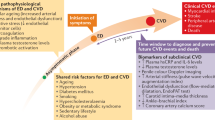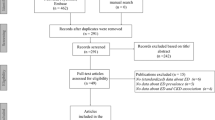Abstract
The aim of this Core Document of the Spanish Consensus on Erectile dysfunction (ED) is to offer guidance to the nonspecialist physician in the management of patients with ED. ED is one of the most frequent chronic health problems in men older than 40 y of age and may also act as a sentinel symptom for other important underlying diseases. Its etiology can be classified into organic, psychogenic, or mixed. In most cases, the underlying cause of ED is usually a chronic health problem (such as diabetes, hypertension, atherosclerosis, and so on) or an adverse drug effect. The initial step in the management is to assess erectile function in patients with risk factors for ED. Once ED has been established, a detailed sexual, medical, and social history, including a review of medications used, is the most important aspect of a patient's assessment. Generally, examination should be limited to the cardiovascular, neurological, and urogenital systems. Fasting glucose and blood lipid profile should be performed in every man with ED, and free testosterone levels in men older than 50 y or if hypogonadism is suspected; other diagnostic tests are optional and should be requested on an individualized basis. In many cases, the most likely cause of ED can be identified based on the above information. Therapeutic intervention should be patient-oriented and based on the expectations and wishes of the patient and his partner, who should be included in discussions whenever possible. Basic interventions common to any type of ED include sexual counseling, lifestyle modifications, treatment of associated medical conditions, and switching to alternative drugs with lower risk of ED. In certain cases, an etiologic treatment may be performed (sex therapy, revascularization surgery, and hormonal therapy). Most patients with ED will benefit from symptomatic treatments; first-line therapy may be prescribed by physicians who are not specialists in ED, and includes oral agents such as inhibitors of phosphodiesterase type 5, currently considered the drugs of choice for initial treatment of ED. Intracavernous drugs are the second-line therapy, and surgical treatments, such as implantation of penile prostheses, are reserved for urologists/andrologists who specialize in ED. Referral may be appropriate where indicated by age, clinical findings, or the patient's request.
This is a preview of subscription content, access via your institution
Access options
Subscribe to this journal
Receive 8 print issues and online access
$259.00 per year
only $32.38 per issue
Buy this article
- Purchase on Springer Link
- Instant access to full article PDF
Prices may be subject to local taxes which are calculated during checkout
Similar content being viewed by others
References
Feldman HA et al. Impotence and its medical and psychosocial correlates: results of the Massachusetts Male Aging Study. J Urol 1994; 151: 54–61.
Althof SE . Quality of life and erectile dysfunction. Urology 2002; 59: 803–810.
NIH Consensus Conference. Impotence. NIH Consensus Development Panel on Impotence. JAMA 1993; 270: 83–90.
Guideline for the investigation and management of erectile dysfunction. Alberta Medical Association, 1630008, Edmonton, AB, June 2001, p 9.
Martin-Morales A et al. Prevalence and independent risk factors for erectile dysfunction in Spain: results of the Epidemiologia de la Disfuncion Erectil Masculina Study. J Urol 2001; 166: 569–574, discussion 574–575.
Benet AE, Melman A . The epidemiology of erectile dysfunction. Urol Clin N Am 1995; 22: 699–709.
McCulloch DK et al. The prevalence of diabetic impotence. Diabetologia 1980; 18: 279–283.
Fedele D et al. Erectile dysfunction in type 1 and type 2 diabetics in Italy. On behalf of Gruppo Italiano Studio Deficit Erettile nei Diabetici. Int J Epidemiol 2000; 29: 524–531.
Nathan DM, Singer DE, Godine JE, Perlmuter LC . Non-insulin-dependent diabetes in older patients. Complications and risk factors. Am J Med 1986; 81: 837–842.
DeWire DM . Evaluation and treatment of erectile dysfunction. Am Fam Physician 1996; 53: 2101–2108.
Jensen J et al. The prevalence and etiology of impotence in 101 male hypertensive outpatients. Am J Hypertens 1999; 12: 271–275.
Cuellar de Leon AJ et al. [Prevalence erectile dysfunction in patients with hypertension]. Med Clin (Barc) 2002; 119: 521–526.
Rosen MP et al. Cigarette smoking: an independent risk factor for atherosclerosis in the hypogastric-cavernous arterial bed of men with arteriogenic impotence. J Urol 1991; 145: 759–763.
Keene LC, Davies PH . Drug-related erectile dysfunction. Adverse Drug React Toxicol Rev 1999; 18: 5–24.
Rosen RC et al. The International Index of Erectile Function (IIEF): a multidimensional scale for assessment of erectile dysfunction. Urology 1997; 49: 822–830.
Rosen RC et al. Development and evaluation of an abridged, 5-item version of the International Index of Erectile Function (IIEF-5) as a diagnostic tool for erectile dysfunction. Int J Impot Res 1999; 11: 319–326.
Miller TA . Diagnostic evaluation of erectile dysfunction. Am Fam Physician 2000; 61: 95–104, 109–110.
Ralph D, McNicholas T . UK management guidelines for erectile dysfunction. BMJ 2000; 321: 499–503.
Jeremy JY, Mikhailidis DP . Cigarette smoking and erectile dysfunction. J R Soc Health 1998; 118: 151–155.
Derby CA et al. Modifiable risk factors and erectile dysfunction: can lifestyle changes modify risk? Urology 2000; 56: 302–306.
Jardin A, Wagner G, Khouri Sea. Recommendations of the 1st International Consultation on Erectile Dysfunction. In: Jardin A, Wagner G, Khouri S, Giuliano F, Padma-Nathan H, Rosen R (eds). Erectile Dysfunction. Health Publication Ltd: Plymouth UK, 2000, pp 709–726.
Greiner KA, Weigel JW . Erectile dysfunction [see comments]. Am Fam Physician 1996; 54: 1675–1682.
Goldstein I et al. Oral sildenafil in the treatment of erectile dysfunction. N Engl J Med 1998; 338: 1397–1404.
Morales A et al. Clinical safety of oral sildenafil citrate (VIAGRA) in the treatment of erectile dysfunction. Int J Impot Res 1998; 10: 69–74.
Boolell M, Gepi-Attee S, Gingell JC, Allen MJ . Sildenafil, a novel effective oral therapy for male erectile dysfunction. Br J Urol 1996; 78: 257–261.
Eardley I et al. Sildenafil (VIAGRA[R]), a novel oral treatment with rapid onset of action for penile erectile dysfunction [abstract]. Br J Urol 1997; 79(Suppl 4): 66.
Buvat J et al. Sildenafil (VIAGRA™), an oral treatment for erectile dysfunction: a 1-year, open-label, extension study [abstract]. J Urol 1997; 157: 204, abstract 793.
Lue T . Sildenafil study group: a study of sildenafil, a new oral agent for treatment of male erectile dysfunction. J Urol 1997; 157(Suppl): 181.
Rendell MS et al. Sildenafil for treatment of erectile dysfunction in men with diabetes. JAMA 1999; 281: 421–426.
Derry F et al. Sildenafil (Viagra) a double blind, placebo-controlled, single dose, two-way crossover study in men with erectile dysfunction caused by traumatic spinal cord injury. J Urol 1997; 157(Suppl): 181.
Quirk F et al. Effect of sildenafil (VIAGRA™) on quality-of-life parameters in men with broad-spectrum erectile dysfunction. J Urol 1998; 159: 260, abstract 998.
Hatzichristou DG . Sildenafil citrate: lessons learned from 3 years of clinical experience. Int J Impot Res 2002; 14(Suppl 1): S43–S52.
Guay AT, Perez JB, Jacobson J, Newton RA . Efficacy and safety of sildenafil citrate for treatment of erectile dysfunction in a population with associated organic risk factors. J Androl 2001; 22: 793–797.
Brotons Munto F et al. Manejo de las disfuncion erectil en atencio primaria. JANO Med Humanidades 1998; 55: 42–46.
Arruda AM, Mahoney DW, Nehra A, Pellikka PA . Cardiovascular effects of sildenafil citrate (Viagra) during exercise in patients with known or probable coronary artery disease. Presented at the Third World Congress on the Aging Male, February 7–10, 2002, Berlin, Germany.
Altwein JE, Keuler FU . Oral treatment of erectile dysfunction with apomorphine SL. Urol Int 2001; 67: 257–263.
Cookson MS, Nadig PW . Long-term results with vacuum constriction device. J Urol 1993; 149: 290–294.
Rodriguez Vela L et al. Tratamiento de la disfuncion erectil mediante farmacoterapia intracavernosa. Actas Urol Esp 1998; 22: 291–319.
Mulhall JP, Ahmed A, Branch J, Parker M . Serial assessment of efficacy and satisfaction profiles following penile prosthesis surgery. J Urol 2003; 169: 1429–1433.
Author information
Authors and Affiliations
Corresponding author
Appendices
Appendix A
International Index of Erectile Function (IIEF) (See Table A1)
Appendix B
Sexual Health Inventory for Men (SHIM) (See Table A2)
Appendix C
Decision Algorithm for Patients With Erectile Dysfunction (See Table A3)
Appendix D
Referral Algorithm for Patients With Erectile Dysfunction (See Table A4)
Rights and permissions
About this article
Cite this article
Brotons, F., Campos, J., Gonzalez-Correales, R. et al. Core document on erectile dysfunction: key aspects in the care of a patient with erectile dysfunction. Int J Impot Res 16 (Suppl 2), S26–S39 (2004). https://doi.org/10.1038/sj.ijir.3901240
Published:
Issue Date:
DOI: https://doi.org/10.1038/sj.ijir.3901240
Keywords
This article is cited by
-
Hypogonadism in DM1 and its relationship to erectile dysfunction
Journal of Neurology (2011)
-
Erectile dysfunction in successfully treated lymphoma patients
Supportive Care in Cancer (2008)



